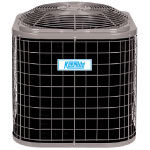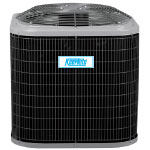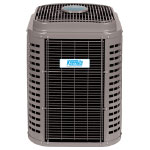AIR CONDITIONING
Comfort All Summer
Winnipeg Home Services offers the broadest array of air conditioning systems in the area. With today's high-efficiency equipment you can make your cooling dollars stretch further than they ever could have before. Call today and schedule a consultation to see what a properly fitted, new Air Conditioner can do for you.
Featured Air Conditioning
Good
Performance 13 Central Air Conditioner

Keep the heat out during the warm months with our budget-friendly central air conditioner with a single-stage compressor. Enjoy cooling comfort and reliability in this affordable model.
Better
Performance 16 Central Air Conditioner

Now you can keep cool and comfortable in the warm months with our high efficiency air conditioner with a single-stage compressor. It delivers reliable cooling comfort and is ENERGY STAR® qualified so you can enjoy money-saving, efficient comfort.
Best
ProComfort™ Deluxe 19 Air Conditioner

Enjoy comfort without compromise, thanks to our variable-speed air conditioner with SmartSenseTM technology. This whisper-quiet system senses changing conditions and adapts so you can stay comfy with outstanding efficiency. And when it gets extra hot and sticky outside, you'll feel the difference with enhanced dehumidification inside. For maximum performance along with the convenience of remote access, pair it with a complete communicating system, including the energy-smart Ion™ System Control with Wi-Fi® capability.
What to look for when replacing or installing a new air conditioning system
- SEER rating
HVAC technology has improved a lot over the years. The Seasonal Energy Efficiency Ratio (SEER) is a rating lets you know what to expect in terms of energy-efficiency cost savings and environmental standards. In general, a higher rating means a more efficient system. Air Conditioning Your Home - The right fit for the size of your house
Select a central air conditioner size or capacity to just meet the design cooling-load calculated. Oversizing the unit will result in short operating cycles, which will not adequately remove humidity, resulting in an unpleasantly cold and damp home. Under sizing the unit will result in an inability to attain a comfortable temperature on the hottest days.
Also, with a central air conditioning system, the equipment cost is much more proportional to size than it is with heating equipment. Unnecessary oversizing will increase the purchase price and increase on-and-off cycling, which will decrease the unit's overall efficiency. - Programmable thermostat
Setting the time and temperature of your air conditioner around your lifestyle can save you money on your energy bill. This technology is now available on smart phones or a smart home device. - Make informed decisions
If you get a great deal on the wrong unit, you might save money upfront, but your monthly operating cost will increase. Take your time and make an informed decision. Talk to one of our qualified professional technicians about makes, models and the right size that’ll suit your home and your needs. Consultations are free.
How Air Conditioning Works
An air conditioner can change the temperature, humidity or general quality of the air. More specifically, an air conditioner makes your home cooler, by drawing heat energy out of the house and transferring that heat to the outdoors, then replacing the air inside your home with cooler air.

The air conditioner in a central heating and cooling system provides cool air through ductwork inside your home, by providing a process that draws out the warm air inside, removing its heat. In a split system, the compressor condenses and circulates the refrigerant through the outdoor unit, changing it from a gas to a liquid. The liquid is then forced through the indoor evaporator coil or cooling compartment. The indoor unit’s fan circulates the inside air to pass across the evaporator fins. The evaporator’s metal fins exchange the thermal energy with the air around it. There, the refrigerant turns from liquid into vapor, removing any heat from the surrounding air. As the heat is removed from the air, the air is cooled and blown back into the house.
From that point, the condenser or outdoor unit then turns the refrigerant vapor back into a liquid, removing any heat. By the time the fluid leaves the evaporator again, it is a cool, low-pressure gas, eventually returning to the condensor to begin its trip all over again. This process continues again and again until your home reaches the cooling temperature you want, as programmed and sensed by your thermostat setting.

How Heat Pumps Work
Think of a heat pump as a heat transporter constantly moving warm air from one place to another, to where its needed or not needed, depending on the season. Even in air that's seems too cold, heat energy is present. When it's cold outside a heat pump extracts this outside heat and transfers it inside. When it’s warm outside, it reverses directions and acts like an air conditioner, removing heat from your home.
Common Cooling Problems
- Check the breaker to ensure it hasn't been tripped
- Check to see if the air filter is blocked – this can cause the cooling coils to freeze
- Change filter, Shut off your AC - Allow any ice on the evaporator coil or refrigerant lines to melt – and restart your system
- If it happens again you will have to call for service
Mold and mildew can accumulate from condensation on the refrigerator coils. Clear any clogs from the drain pan.
Blocked vents, ductwork inefficiencies, air leaks near windows and doors can cause temperature imbalances.
Loose parts, broken isolation feet, refrigerant leaks, or a malfunctioning compressor are some causes for noise.
The fan may not be running, or is running too slow.
The evaporator coil may be frozen and liquid refrigerant is flowing to the outside unit through the refrigerant line.
- Check the breaker to ensure it hasn't been tripped
- Check your thermostat's fuse
Damper valves in the ducts that control airflow may be closed or there may be furniture blocking air vents.
This can be caused if the insulation under the floor of your home isn’t adequate enough to stop the underground air from meeting the conditioned air of your house.
Energy Bill Savings Tips
Ensure your heating system is warming your home at optimum levels when you want it. Here's how you can save:
- Routine system inspections
- Sealing of vents and duct work
- Proper duct, window, vent and home insulation
- Adjustment of gas pressure
- Routine cleaning and servicing of HVAC motor, exchangers and coils
- Implementation of zoning systems
- Odd noises from heater/furnace
- Maintaining a clean blower




